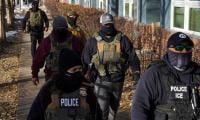Pak-Afghan border fencing to be done in phases
ISLAMABAD: At last, Pakistan has taken the first major stride in the long journey of fencing over 2,400-kilometer long border with Afghanistan, involving billions of rupees, to check infiltration of terrorists from across the border once and for all.
To start with, the fencing has been commenced in the high threat zones of Bajaur and Mohmand agencies in the Federally Administered Tribal Areas (Fata). Moreover additional technical surveillance means are also being deployed along the border besides regular air close watch for the same purpose, according to Chief of Army Staff General Qamar Javed Bajwa.
Credible information is available with the government that most incursions of terrorists, who strike in different parts of Pakistan, take place through these agencies. Therefore, they have to be immediately plugged.
For years, Pakistan has forcefully argued with Washington to provide financial support for fencing of the Pak-Afghan border as Islamabad is not in a position to mobilize such huge funding, but the US has never paid any attention to it. The result is that cross border movements have largely been going on unchecked. Indeed, in the absence of stringent measures, such mobility can’t be controlled.
Finally, the Pakistan government has decided to spare funds for fencing in phases as it can’t do it in one go due to scarcity of resources. The decision was taken at a high level meeting chaired by Prime Minister Nawaz Sharif that was also attended by the army chief before the premier visited Kuwait early this month.
During his trip, he disclosed to the accompanying media men that it has been decided to fence the Pak-Afghan border as a major step to curb unrestrained cross-border movements with a view to eliminating illegal infiltrations from Afghanistan.
The civ-mil leaderships reached this conclusion after the recent wave of suicide bombings that claimed more than 100 lives in Lahore, Sehwan Sharif and other areas. It was determined that there was no option but to fence the border due to lack of any worthwhile cooperation from Afghanistan to rein in the terrorists, holed up in safe havens there.
Finance Minister Senator Ishaq Dar continues to liaise and coordinate with the top military leadership so that there is no impediment in the smooth flow of funds for such national security enterprises.
Bajaur Agency, the smallest agency of the Fata with a hilly terrain, borders the Kunar province of Afghanistan with a 52-kilometer border. The Mohmand Agency is bounded by Bajaur Agency to the north, Khyber Agency to the south, Malakand and Charsadda districts to the east and Peshawar district to the southeast.
The Bajaur Agency is about 72 km long and 32 km broad, and lies at a high level to the east of the Kunar Valley from which it is separated by a continuous line of rugged frontier hills, forming a barrier easily passable at one or two points, according to Wikipedia. Across this barrier, the old road from Kabul to Pakistan ran before the Khyber Pass was adopted as the main route.
To the south of Bajaur is the mountain district of the Mohmands. To the east, beyond the Panjkora river, are the hills of Swat. To the north is an intervening watershed between Bajaur and the small Tehsil of Dir. It is over this watershed and through the valley of Dir that the new road from Malakand and the Punjab runs to Chitral.
The drainage of Bajaur flows eastwards, starting from the eastern slopes of the dividing ridge, which overlooks the Kunar and terminating in the Panjkora river so that the district lies on a slope tilting gradually downwards from the Kunar ridge to the Panjkora.
Pakistan has 2,430-kilomter (1,510 miles) international border with Afghanistan. It was established in 1896 between Sir Mortimer Durand, a British diplomat and civil servant of British India, and Abdur Rahman Khan, the Afghan Amir, to fix the limit of their respective spheres of influence and improve diplomatic relations and trade.
Afghanistan was considered by the British as an independent princely state at the time although the British controlled its foreign affairs and diplomatic relations. The single-page agreement dated 12 November 1893 contains seven short articles, including a commitment not to exercise interference beyond the Durand Line. A joint British-Afghan demarcation survey took place starting from 1894, covering some 800 miles of the border.
The Pak-Afghan border cuts through the Pashtun tribal areas and further south through the Balochistan region. It demarcates Khyber Pakhtunkhwa, Fata, Balochistan and Gilgit-Baltistan from the northeastern and southern provinces of Afghanistan. From a geopolitical and geostrategic perspective, it has been described as one of the most dangerous borders in the world.
-
 First Poll Since King Charles' Action Against Andrew Reveals Royal Family's Public Standing
First Poll Since King Charles' Action Against Andrew Reveals Royal Family's Public Standing -
 Blake Lively Strengthens Legal Team Ahead Of Justin Baldoni Trial
Blake Lively Strengthens Legal Team Ahead Of Justin Baldoni Trial -
 'Back To School!': Palace Shares Details Of Princess Anne's Latest Engagements
'Back To School!': Palace Shares Details Of Princess Anne's Latest Engagements -
 Paul Mescal Clarifies Acting Break Comment As He Teases Paul McCartney Role
Paul Mescal Clarifies Acting Break Comment As He Teases Paul McCartney Role -
 Kate Middleton's Unexpected Style Of Arrival At Solo Outing Goes Viral
Kate Middleton's Unexpected Style Of Arrival At Solo Outing Goes Viral -
 Why ‘X’ Is Down? Thousands Report Twitter Outage: Here’s What You Can Do
Why ‘X’ Is Down? Thousands Report Twitter Outage: Here’s What You Can Do -
 Florida Man Held After Alleged Nail-scattering On Busy Intersections
Florida Man Held After Alleged Nail-scattering On Busy Intersections -
 Valeria Nicov: Sean Penn's Athletic Girlfriend Raises Eyebrows With Latest Photos
Valeria Nicov: Sean Penn's Athletic Girlfriend Raises Eyebrows With Latest Photos -
 Sharon Stone Lashes Out At Fellow Award Show Attendees After Stealing Accusations
Sharon Stone Lashes Out At Fellow Award Show Attendees After Stealing Accusations -
 Gwyneth Paltrow Reveals Real Reason She Said Yes To 'Marty Supreme'
Gwyneth Paltrow Reveals Real Reason She Said Yes To 'Marty Supreme' -
 King Charles Says He And Queen Camilla Stand With People Of Ukraine
King Charles Says He And Queen Camilla Stand With People Of Ukraine -
 Ben Affleck Argues In Favour Of His Shirtless Scene In 'The Rip'
Ben Affleck Argues In Favour Of His Shirtless Scene In 'The Rip' -
 Mississippi Postal Worker Arrested After Complaints Of Marijuana Odour In Letters
Mississippi Postal Worker Arrested After Complaints Of Marijuana Odour In Letters -
 Canada, China Lock Initial Trade Deal On ‘EV,Canola’ To Strengthen Ties: What To Expect Next?
Canada, China Lock Initial Trade Deal On ‘EV,Canola’ To Strengthen Ties: What To Expect Next? -
 Melissa Leo On Euphoria Of Winning An Oscar Vs It's Impact On Career
Melissa Leo On Euphoria Of Winning An Oscar Vs It's Impact On Career -
 Meghan Markle, Prince Harry Express 'hope' In Latest Major Statement
Meghan Markle, Prince Harry Express 'hope' In Latest Major Statement



